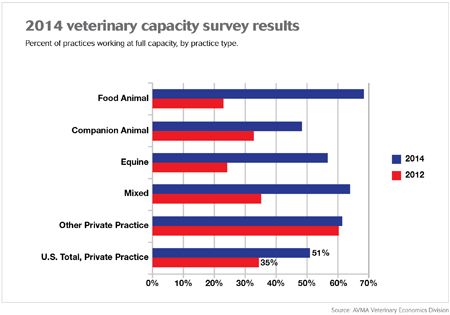Data suggest veterinary market will improve in 2015
Forecasts predict an increase in GDP and consumers disposable income.
Recent indicators tracked by the AVMA's Division of Veterinary Economics suggest that the challenges confronting veterinary practices the past few years are improving.
More veterinarians are being absorbed into the workforce, more practices are operating at what they believe is full capacity and veterinary compensation has finally resumed growing. However, there are still practices operating well below optimal levels, there continues to be many veterinarians that want to work more hours for greater compensation and, even with recent increases, compensation has still not returned to pre-recession levels.
The economic recovery has entered its sixth year. The difference between what the country's total gross output should be and its real level sparks considerable debate. The gap is estimated to be between $600 and $900 billion annually, depending on the source. This gap in the U.S. gross domestic product (GDP)-the measure of the value of all final goods and services produced-has allowed the economy to grow without allowing increases in the average worker's wage. Accordingly, consumers' disposable income has not risen. The good news is that all evidence suggests that this is likely to change in 2015.
The Congressional Budget Office estimates that GDP will grow 3.4 percent this year and in 2016, and the GDP gap will close by 2018. The Conference Board, a global, independent business research association working in the public interest which produces an index of leading indicators and has consistently and accurately predicted the nation's recessions and recovery, has predicted that the U.S. economy will continue to gain strength 12 to 18 months into the future.
Interpreting the impact of economic growth
All other factors aside, strong growth in GDP should translate into increased demand for veterinary services. Does this mean all veterinary practices will see an improvement next year? Unfortunately, the caveat of “all other factors” will likely determine whether a strong growth in the GDP will translate into an increased demand for veterinary services. More importantly, how will an increase in the demand for veterinary services translate into an increase in veterinary compensation?

Based on the Bureau of Census' population growth forecast and AVMA's determination of the demographic characteristics that influence pet ownership, U.S. pet population growth will continue to outpace the growth in the number of veterinarians. However, the percentage of pets visiting veterinary practices has been declining for a decade. The average visit includes the purchase of four services, and at least two are a wellness exam and vaccination(s).
In a recent study commissioned by AVMA, the price elasticity-the effect changing price has on the quantity consumed-of demand for the wellness exam was estimated to be slightly greater than 1 (see the Sept. 1, 2014, issue of JAVMA). This means for every 1 percent that you raise your exam price, demand will decrease 1 percent.
The income elasticity of demand was found to be a little bit less than 1 for pet owners who don't believe the wellness exam is very important, and 0.3 for those who do believe it is necessary.
What does this mean to you? It means that raising the price of the wellness exam may reduce the number of clients to such an extent that revenue from wellness exam visits will decline.
An increase in consumer income will only slightly increase the demand for wellness exams for pet owners who view the exam as important, but it would substantially increase the demand for the pet owners who do not believe it is important.
A statistical relationship exists between GDP per capita and veterinary compensation. For every $1,000 decline in per capita GDP, veterinary compensation has declined by roughly $1,700. This relationship indicates a connection between GDP and the market for veterinary services and veterinarians.
Food animal, equine
Both the total number of food animals and the number of small scale food animal owners fell precipitously during the recession. Not only did demand for meat decline as a result of lower per capita income, but droughts, high feed prices and forage shortages pushed animal production profitability into very low or negative territory, especially for small scale producers, adversely affecting the demand for veterinary services.

With the economy improving, demand has returned. However, we still have a historically low number of food animals. With cheaper feed and plenty of forage available, expansion in the industry, especially among small scale producers, is occurring. This, plus the increase in value of each animal, will increase the demand for veterinary services. Veterinarians involved in food animal medicine noted the greatest reduction in excess capacity in their practices over the last two years.
Equine practitioners also noted solid gains in the number of practices now working at full capacity when compared to two years ago.The market for horses has improved. Cheaper grain and more abundant forage have certainly helped expand that demand.
Take-away for veterinarians
We need to keep in mind that all markets are national, but all veterinary practices are local. A rising GDP will help all markets, some more than others. Because some states, cities and certain business types feel the impacts of the economy more quickly than others, the effect of strong GDP growth on any specific veterinary practice will vary considerably. That said, the next 12 to 18 months should be a period of strong financial improvement for veterinary practices.
If your practice isn't benefiting from that improvement, take a careful look at your local economic conditions as well as your practice's operations.
Dr. Mike Dicks, director of the AVMA's Veterinary Economics Division, holds a doctorate in agricultural economics from the University of Missouri. He has worked in Africa on water delivery and energy production technologies and has served with the USDA's Economic Research Service.